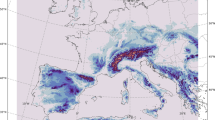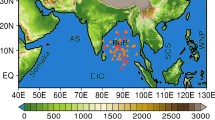Abstract
This observational study considers Caribbean cyclogenesis in the period 2003–2009. Numerous events are identified from maximum of low-level relative vorticity and rain rate, and a case study is analyzed. Although fast moving tropical cyclones (TC) pose dangers to Caribbean Islands, it is the slower moving TC that inflict flood damage. The Atlantic warm pool enlarges through October as steering winds slacken. African easterly waves move over the warm pool and draw moist unstable air, while near-equatorial Kelvin waves from the Pacific surge into the Caribbean. The westerly flow accelerates around the northern Andes and is drawn into TC Omar 13–15 October 2008. A combination of warm pool air and cyclonic vorticity provided by transient zonal waves sets off the process of cyclogenesis.








Similar content being viewed by others
References
Aiyyer A, Molinari J (2008) MJO and tropical cyclogenesis in the Gulf of Mexico and Eastern Pacific: case study and idealized numerical modeling. J Atmos Sci 65:2691–2704
Bessafi M, Wheeler MC (2006) Modulation of South Indian Ocean tropical cyclones by the Madden–Julian oscillation and convectively coupled equatorial waves. Mon Weather Rev 134:638–656
Beven JL, Landsea C (2009) Hurricane Omar, Tropical Cyclone Report, National Hurricane Center, February 2009. Available at www.nhc.noaa.gov/2008atlan.-shtml
Camargo SJ, Wheeler MC, Sobel AH (2009) Diagnosis of the MJO modulation of tropical cyclogenesis using an empirical index. J Atmos Sci 66:3061–3074
Chand SS, Walsh KJE (2010) The influence of the Madden–Julian oscillation on tropical cyclone activity in the Fiji region. J Climate 23:868–886
Frank WM, Roundy PE (2006) The role of tropical waves in tropical cyclogenesis. Mon Weather Rev 113:647–658
Hogsett W, Zhang D-L (2010) Genesis of typhoon Chanchu from a westerly wind burst associated with the MJO. Part I: synoptic evolution of a vertically tilted precursor vortex. J Atmos Sci. doi:10.1175/2010JAS3446.1
Joyce RJ, Janowiak JE, Arkin PA, Xie PP (2004) CMORPH: a method that produces global precipitation estimates from passive microwave and infrared data at high spatial and temporal resolution. J Hydrometeorol 5:487–503
Jury MR (2009) An inter-comparison of observational, reanalysis, satellite, and coupled model data on mean rainfall in the Caribbean. J Hydrometeorol 10:413–430
Jury MR, Winter A, Malmgren B (2007) Sub-regional precipitation climate of the Caribbean and relationships with ENSO and NAO. J Geophys Res 112:D16107. doi:10.1029/2006JD007541
Kanamitsu M, Ebisuzaki W, Woollen J, Yang SK, Hnilo JJ, Fiorino M, Potter GL (2002) NCEP-DOE AMIP-II Reanalysis (R-2). Bull Am Meteorol Soc 83:1631–1643
Kiladis GN, Wheeler MC, Haertel PT, Straub KH, Roundy PE (2009) Convectively coupled equatorial waves. Rev Geophys 47:RG2003. doi:10.1029/2008RG000266
Klotzbach PJ (2010) On the Madden–Julian oscillation–Atlantic hurricane relationship. J Climate 23(2):282–293
Kossin JP, Camargo SJ, Sitkowski M (2010) Climate modulation of north Atlantic hurricane tracks. J Climate 23:3057–3076
Maloney ED, Esbensen SK (2003) The amplification of East Pacific Madden–Julian oscillation convection and wind anomalies during June–November. J Climate 16:3482–3497
Maloney ED, Hartman DL (2000) Modulation of hurricane activity in the Gulf of Mexico by the Madden–Julian oscillation. Science 287:2002–2004
Maloney ED, Sobel AH (2004) Surface fluxes and ocean coupling in the tropical intraseasonal oscillation. J Climate 17:4368–4386
Mesinger F et al (2006) North American regional reanalysis. Bull Am Meteorol Soc 87:343–360
Molinari J, Lombardo K, Vollaro D (2007) Tropical cyclogenesis within an equatorial Rossby wave packet. J Atmos Sci 64:1301–1317
Reynolds RW, Smith TM, Liu C, Chelton DB, Casey KS, Schlax MG (2007) Daily high-resolution blended analyses for sea surface temperature. J Climate 20:5473–5496
Sheffield J, Goteti G, Wood EF (2006) Development of a 50-yr high-resolution global dataset of meteorological forcings for land surface modeling. J Climate 19(13):3088–3111
Wang B, Rui H (1990) Dynamics of the coupled moist Kelvin–Rossby wave on an equatorial β-plane. J Atmos Sci 47:397–413
Wang C, Enfield DB, Lee S-K, Landsea CW (2006) Influences of the Atlantic warm pool on western hemisphere summer rainfall and Atlantic hurricanes. J Climate 19:3011–3028
Wheeler M, Kiladis GN (1999) Convectively coupled equatorial waves: analysis of clouds and temperature in the wave number–frequency domain. J Atmos Sci 56:374–399
Zehnder JA, Powell DM, Ropp DL (1999) The interaction of easterly waves, orography, and the intertropical convergence zone in the genesis of Eastern Pacific tropical cyclones. Mon Weather Rev 127:1566–1585
Acknowledgements
Data and analyses were drawn from the websites: ingrid.ldgo.columbia.edu, disc.sci.gsfc.nasa.gov/giovanni, ready.arl.noaa.gov, weather.uwyo.edu/upperair/, nomads.ncdc.noaa.gov/, climexp.knmi.nl/, www.ndbc.noaa.gov/, amdar.noaa.gov/, and www.nrlmry.navy.mil/tc_pages/.
Author information
Authors and Affiliations
Corresponding author
Rights and permissions
About this article
Cite this article
Jury, M.R. Caribbean hurricanes: case study of interacting easterly and westerly waves. Theor Appl Climatol 106, 117–126 (2011). https://doi.org/10.1007/s00704-011-0424-x
Received:
Accepted:
Published:
Issue Date:
DOI: https://doi.org/10.1007/s00704-011-0424-x




